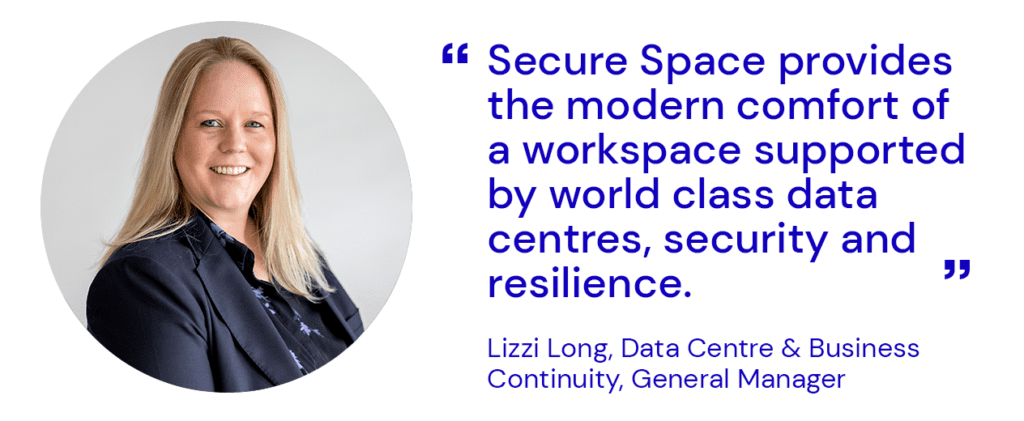Finding a new home for critical infrastructure
While the great exodus has occurred, we’re seeing the inverse happening within critical infrastructure organisations.
Adoption, migration, optimisation, security and management services designed to deliver business agility.
Improve your security posture with tailored strategies and front-line defence services.
Scalable colocation and connectivity within a hyper secure environment.
Disaster recovery and serviced offices in secure, premium office facilities.
Tailored end-to-end solutions for your hardware ecosystem across the widest range of vendors.
Seamless management of your IT environment, underpinned by world-class cyber security, no matter where you are on your journey.
Securely and effectively operate, monitor and maintain your network.
Enjoy the comfort of a modern working space supported by world class technology, security and resilience.
Help your clients take control of their IT environment with Australia and New Zealand’s leading hardware maintenance provider.
Interactive Anywhere provides robust infrastructure solutions designed to support the seamless operation of digital environments. These solutions include scalable cloud services, reliable data storage, and efficient server management, ensuring optimal performance and uptime.
The network solutions from Interactive Anywhere encompass comprehensive design, implementation, and maintenance of secure and efficient networks. By optimising connectivity and bandwidth, these solutions facilitate seamless communication and data transfer, enhancing overall productivity and operational efficiency.
Interactive Anywhere offers dedicated end user support services that ensure users receive prompt assistance with technical issues. This includes help desk support, troubleshooting, and training, aimed at improving user experience and minimising downtime for businesses.
With a focus on safeguarding digital assets, Interactive Anywhere's cyber security solutions provide advanced protection against cyber threats. These solutions include threat detection, risk management, and compliance services, ensuring businesses can operate securely and with confidence.
Interactive offers financial institutions with secure operations, robust cyber security, seamless connectivity, end-user support, and cloud solutions, ensuring long-term resilience.
For manufacturing, precision and efficiency are paramount. Our solutions optimise operations, streamline processes, and ensure seamless connectivity to drive productivity and innovation.
In professional services, reliability and agility are crucial. Our solutions enhance efficiency, streamline workflows, and provide seamless connectivity, empowering firms to deliver exceptional client experiences and stay ahead in a dynamic market.
In aged care, precision and patient well-being are fundamental. Our solutions enhance operational efficiency, streamline workflows, and guarantee secure, seamless connectivity, empowering providers to deliver exceptional care and lead in an ever-evolving sector.
We're Australia's leading IT service provider and we keep technology human.
News & insights from our experts to help you drive performance and grow your business.

A lot has been said about the post-pandemic office worker diaspora. Many businesses have shifted to hybrid or remote working models, and the result is a decentralised labour force.
The last few years highlighted how important flexibility in work is, not only for people, but also for companies. Business leaders are rushing to build capacity within their operations to quickly react to economic pressures and unforeseen disruptions.
Gone are the days of ten-year office leases. Companies are abandoning costly and expansive CBD real estate in favour of accessible, right-sized office locations for in-person interactions.
While this great exodus has occurred, we’re seeing the inverse happening within critical infrastructure organisations.
For companies operating within heavily regulated sectors such as banking, healthcare, telecommunications, and gas and energy, critical infrastructure has been part and parcel of their operations since they first began.
The recent amendment of the Security of Critical Infrastructure Act 2018 has meant the criteria for determining which companies in Australia are deemed critical has shifted. Critical infrastructure now includes financial institutions, food and grocery providers, and even some technology retailers. These companies are bringing teams closer, while many others are spreading out as a result of hybrid work.
Many smaller companies that have not encountered international security regulations are now required to invest millions to comply with global best practices for securing data. Due to the highly sensitive nature of the information they possess, they have become prime targets for cyber-attacks and data breaches.
Companies need to find ways to avoid massive capex blowouts, while also ensuring they have secure data and operations centres that meet regulatory standards and operation needs. This in turn created the need for people and data centres to find a new home, side by side.
Enter, secure, serviced offices. They provide the modern comfort of a workspace supported by world class data centres, security and resilience.

Critical infrastructure security extends beyond digital requirements. Physical penetration is also a major risk for companies dealing with sensitive data. We often see businesses talk about updating their cyber security protocols and protecting their data with firewalls, antivirus and encryption, but they neglect the physical security of their data and operations centres.
Whether building a prototype product, keeping a competitive edge, or handling a complex operations centre that needs constant uptime, the physical security of the workspace makes all the difference.
A secure office space is one way to ensure the safety and security of the premises. With 24/7/365 onsite security and access control, a secure space safeguards a company’s digital infrastructure. With round-the-clock on-site support, any issues that arise are dealt with quickly and efficiently, without the need for lengthy back-and-forth with a remote support desk.
Secure offices allow businesses to bring people, physical resilience, security and their IT infrastructure together to focus on their core operations without worrying about security-related issues.
The importance of resilient power infrastructure for critical business operations cannot be overstated. Businesses that rely on continuous power supply and zero latency when accessing their data, such as control centres, financial institutions, operations centres, lab environments and manufacturing facilities, are particularly vulnerable to power outages. These outages can result in significant financial losses, operational disruptions, and even threats to public safety. Having a resilient power infrastructure that can withstand power interruptions and quickly recover from them is essential for these businesses to operate smoothly and effectively.
Resilient power infrastructure includes measures such as backup power systems, redundant power sources, and load shedding capabilities. Backup power systems, such as generators and uninterruptible power supply (UPS) systems, can provide temporary power during a power outage. Redundant power sources, such as dual utility feeds or multiple backup generators, can provide a backup power supply if one source fails.
These secure offices are set-up with safe, reliable and zero-latency access to high power compute, while the UPS-to-the-desk system ensures that no matter what, a customer can not only access their data, but also continue operating without interruption. This level of power resilience can give customers peace of mind knowing that they are inoculated against weather or power events that would otherwise disrupt their operations.
Bespoke and secure workspaces are finding their position in the market as a solution for evolving critical infrastructure needs. They are much more than just an easy way to save on capex; they are a viable long-term solution for organisations that operate mission critical infrastructure and have sensitive information to protect.
With data volumes growing exponentially, the need to access it is accelerating just as fast. For critical infrastructure, interruption to this supply is not an option, ultimately bringing the people entrusted to operate it closer to the technology.
Enjoy the comfort of a modern working space supported by world class technology, security and resilience.